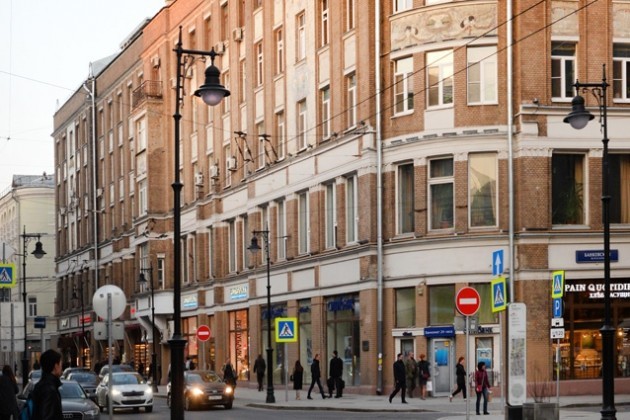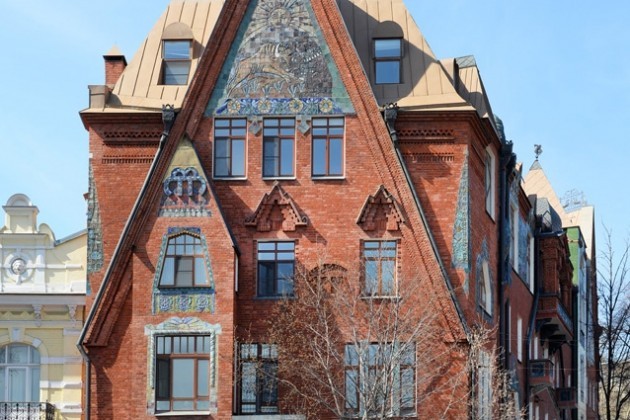Moscow for rent
Surprisingly, the process of mass construction of apartments for rent started in Ancient Rome in the III century BC. Centuries later apartment houses appeared in Moscow. By 1917, the capital had 800 of them and it was about 40% of the total housing fund in Moscow. Many of these houses have been recently restored.
A rich and eccentric man
Among the first apartment buildings in the capital are houses 8 and 10 in Ilyinka street, designed by Matvei Kazakov in 1785-1790 for merchants Kalinin and Pavlov and № 12 for merchant Khryaschev. They had a front 6-columned portico, and shops were located under the numerous arched entrances. Apartments occupied the 2nd and the 3rd floors. In 1816 Osip Bove, another famous architect, built a profitable 3-storey house for bookseller Glazunov in Nikolskaya street (it was demolished, and houses 19-21 took its place). These architects, the masters of classicism and creators of noble country estates, had to adapt their ideas to modern needs.

Rent construction boom first occurred in the 1870-1890-ies. Houses were erected by individuals, various societies and monasteries. To rent an apartment was not so expensive - from 100 to 500 rubles a month. In 1902 Gorky allegedly paid 1000 rubles per year for a 10-room 300 sq. m apartment. There were also houses for the poor - like the house № 65, built in 1906-1908 at the corner of 2nd Meshchanskaya (Gilyarovskogo street).
The richest man of his time, known for his eccentricities, ordered to spend the lion's share of his 20 million fortune for schools, women's schools and houses for the poor. Thus, the "Free Citizen" complex was built, following the principle of a dormitory or commune with cheap apartments (there were more than a thousand in it). It was also called Solodovnikov's House. The complex consists of two buildings, № 65 and № 61 for poor families, a library, a shop, a sauna, a dining room, a laundry room, a nursery and a kindergarten! The buildings are beautiful, made of red brick with white decor, peaked roofs and turrets.

The appearance of many such houses is distinguished by an "Architectural cocktail" of Art Nouveau and Neo-Gothic, going back to the Middle Ages. By the way, these buildings are well preserved, during the Soviet era they were easily adapted to the communal apartments.
In 1911 Gavrila Solodovnikov's son Peter bought the building with the Kremlin view in Lebyazhiy pereulok, 6/1 and then rebuilt it for an apartment house, adding two floors. In had small rooms and housed the Theatre of Miniatures as well as the "Electrotheatre" - a cinema. Genes: his eccentric father also owned a theatre.
Blind architect
At the beginning of the XX century apartments for rent were designed by the geniuses of modern architecture such as Shekhtel and Kekushev. The most famous of these buildings is Schechtel's apartment house - a complex of Stroganov school in Myasnitskaya street, 24/7, bld. 1.

It occupied a whole city block with 5-storey buildings. The school was under the patronage of the Grand Duchess Elizabeth Feodorovna. The best artists and architects of the era studied there (and lived in the apartments of the building). The construction cost 1 million 300 thousand rubles, and the land of the Stroganov school was presented by the Emperor himself! Lev Kekushev's most famous tenement is Isakov's house in Prechistenka street, 28. It was ordered by Moscow Trade and Construction Joint Stock Company. The building is whimsically decorated with lion masks on the visor (Kekushev's trademark), and upstairs there are two reclining female statues-allegories, symbolizing Arts and Education.

Another master is a very popular architect Ivan Kondratenko, who carried out more than 50 projects, 40 of them – houses for rent. A unique lifestory: at the age of 23 he was almost blind and deaf. He modeled his models in clay and his friend and partner Semen Doroshenko helped him to make blueprints. Coming from a peasant's family, Kondratenko graduated from the Moscow School of Painting, Sculpture and Architecture, then the Imperial Academy of Arts. He received the title of "Class artist of architecture 1-st degree", two gold and one silver medals, was a deputy in the City Duma.
He has built apartment houses all around Moscow: in Petrovka street, Tverskaya street, Likhov and other lanes. His most famous building is located in Potapovsky pereulok, 12 (6). The house was ordered by a tradesman Zavarsky for his wife Anastasia. It was called a "knight's castle for a lovely lady". Romanticism, Neo-Gothic, Medieval Western European motifs made a combination with the Neo-Russian, reminding the chambers of Romanov boyars in Varvarka street.
From the life of Bohemia
Many Moscow apartment houses were connected with the people of arts. Such is the "fairy-tale" house of Zinaida Pertsova of 1905-1907 in Soimonovsky lane, 1/35, - the brightest example of colorful Moscow Art Nouveau: majolica panels, decorated in accordance with the sketches of Sergei Malyutin (the author of Russian Matreshka dolls), balconies, propped up by dragons, small animals on the roof. Artists lived in the studios-apartments, and from 1908 to 1912 the legendary cabaret and art-cafe «The Bat» was working here. Stanislavsky acted here as a circus wrestler-athlete, Knipper-Chekhova - as a Paris cabaret singer and Nemirovich-Danchenko conducted the orchestra. Zinaida Pertsova's husband, engineer Pertsov was arrested in 1922, for storing valuables from the Cathedral of Christ the Savior, and after serving the annual sentence, the family was evicted from the house. For some time Trotsky lived in it. Now the building belongs to the Ministry of Foreign Affairs.

Legendary 10-storey "Niernsee house", built in 1913 by architect Niernsee from Warsaw, in Bolshoy Gnezdnikovsky lane, 10, was immediately nicknamed "Tucherez" or "skyscraper". It was the tallest building in the city and one of the highest in Europe (before that Afremov's 8-storey building in Sadovaya-Spasskaya, 19 was considered to be the biggest in the city). Mayakovsky wrote: "Remember, a house is Niernsee stood over the shacks raising up his roof?" In 1913 the house was overlooking indeed its "short" neighbors in Tverskaya street.
The house with inexpensive apartments, without kitchens and without any chic in its interiors was conceived for single bachelors. Besides the apartments, “The Bat” theatre, the "Curve Jimmy" cabaret and the Maly Theater Studio were also located here. As well as the editorial boards of the following newspapers and magazines: "Nakanyne", "Gudok", "Vechernye Izvestya", "Rossia", "Tvorchestvo", "Ogonek", "Sovetsky Pisatel". That is why many of the Soviet celebrities used to visit the building: Esenin, Zoshchenko, Pilnyak, Mandelstam, Kataev. It was here, where Bulgakov met his future wife Elena.
One of the scenes of the very popular Russian comedy "Office Romance" was shot on the broad roof of the building (it is big enough to play football). It was the episode, where against the beautiful view of the city Novoseltsev was reassuring the main character "mymra" Lyudmila Prokofievna.








